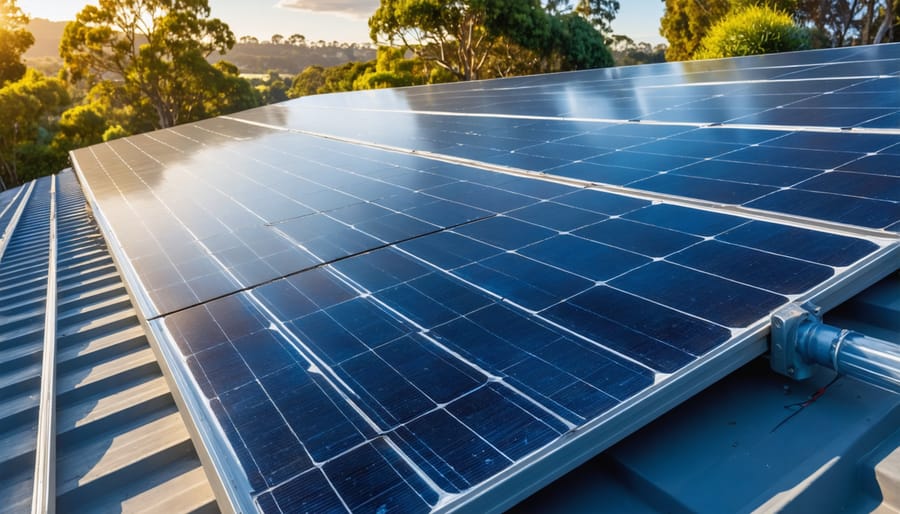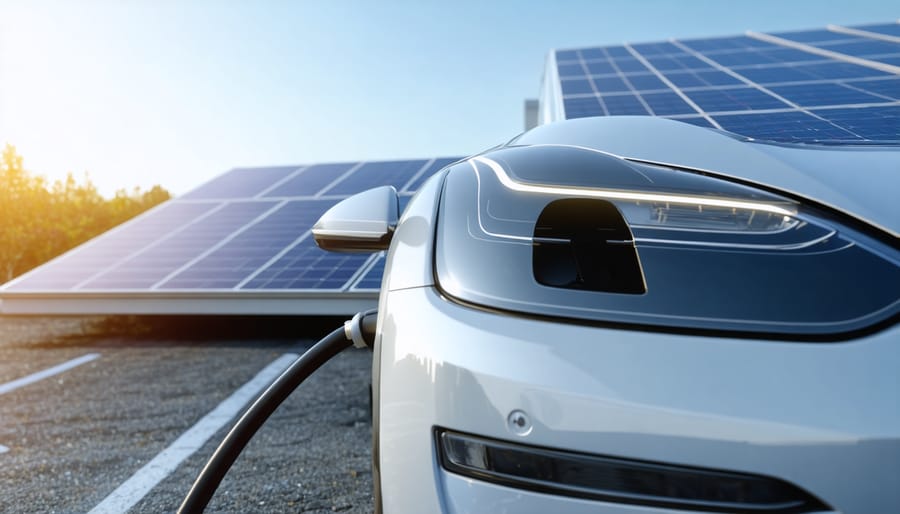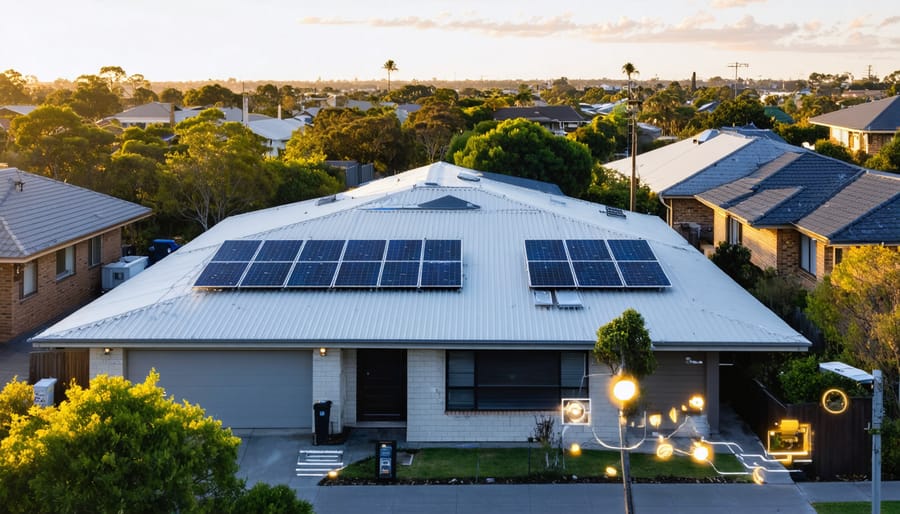**Imagine paying for electricity the moment your solar panels generate it, without paperwork, without middlemen, and without waiting weeks for credits to appear on your bill.** This isn’t science fiction—it’s the promise of smart contracts on blockchain technology, and it’s already transforming how Australians trade renewable energy.
Smart contracts are self-executing digital agreements that automatically trigger actions when specific conditions are met. Picture them as vending machines for the digital age: you insert the right input, and the output happens instantly, no human intervention required. When combined with blockchain—a tamper-proof digital ledger that records every transaction—these contracts create an unprecedented level of trust, transparency, and efficiency in energy markets.
For Australia’s renewable energy sector, this technology is revolutionary. Traditional energy trading involves complex billing systems, intermediaries taking their cut, and lengthy settlement periods. Smart contracts eliminate these bottlenecks. When your rooftop solar system produces excess energy, a smart contract can automatically sell it to your neighbour, transfer funds to your account, and record the transaction on the blockchain—all within seconds.
The implications extend far beyond convenience. Community energy projects in Melbourne and Adelaide are already using blockchain-based smart contracts to enable peer-to-peer energy trading, reducing costs by up to 40% while supporting local renewable generation. These systems empower everyday Australians to become active participants in the clean energy transition, turning homes into mini power stations that contribute to grid stability.
Understanding this technology means grasping the future of sustainable energy in Australia.
What Smart Contracts Actually Are (No Tech Degree Required)

The Traditional Energy Transaction Problem
Right now, when you flick on a light switch in your Brisbane home or power up equipment at your Sydney business, you’re participating in a system that hasn’t fundamentally changed in decades. Your electricity flows through a complex web of intermediaries—retailers, distributors, and network operators—each taking their cut and adding layers of complexity.
Consider this: Australian households often wait weeks for energy account reconciliations, struggle to verify where their power actually comes from, and have virtually no say in supporting local renewable sources directly. When a regional Victorian farm produces surplus solar energy, that clean power can’t easily reach a neighbouring business that wants to buy it. Instead, it must navigate through established retailers and grid operators, with profits and control firmly in their hands.
The lack of transparency means you’re essentially taking your energy company’s word about your consumption and sources. Meanwhile, transaction costs remain high, switching providers is cumbersome, and opportunities for peer-to-peer energy trading—like selling your rooftop solar directly to your neighbour—remain frustratingly out of reach. This centralised system wasn’t designed for today’s renewable energy revolution, where thousands of homes and businesses are becoming energy producers themselves.
How Smart Contracts Change the Game
Smart contracts are like digital agreements that execute themselves automatically when specific conditions are met—no lawyers, no paperwork, no waiting around. Think of them as vending machines for complex transactions: you insert the right input, and the agreed outcome happens instantly.
Here’s where it gets exciting for Australia’s energy future. Traditional energy transactions require multiple intermediaries—retailers, brokers, and administrators—each adding costs and delays. Smart contracts eliminate this middle layer entirely. When your rooftop solar system generates excess power, a smart contract can automatically sell it to your neighbour the moment their demand spikes, with payment settled instantly through blockchain energy trading systems.
The real game-changer? Trust no longer depends on institutions—it’s built into the code itself. The contract only executes when all parties meet their obligations, creating transparent, tamper-proof transactions. For bioenergy producers and renewable energy communities across Australia, this means fairer pricing, reduced administrative costs, and the ability to participate directly in energy markets previously dominated by large corporations. It’s democratising energy in ways we’ve only imagined until now.
Smart Energy Transactions in Action: Real Australian Stories
Peer-to-Peer Solar Trading in Australian Communities
Across Australia, pioneering communities are already experiencing the future of energy through peer-to-peer solar trading platforms powered by smart contracts and blockchain technology. These innovative projects are transforming how neighbours share renewable energy, creating a more sustainable and economically viable energy landscape.
In Western Australia, the RENeW Nexus trial brought together households in several suburbs to trade excess solar power directly with one another. When Sally’s rooftop panels generate more electricity than her family needs on a sunny afternoon, the smart contract automatically sells that surplus to Michael three doors down—without any middleman taking a cut. The transaction happens seamlessly, with blockchain recording every kilowatt-hour traded and ensuring fair payment.
The Power Ledger platform has facilitated similar trials across multiple Australian sites, including a groundbreaking project in Fremantle. Participants report cost savings of 20-30% compared to traditional energy bills, whilst simultaneously supporting their community’s transition to renewables. Beyond the dollars saved, residents speak enthusiastically about the sense of empowerment—they’re no longer passive consumers but active participants in their local energy ecosystem.
These peer-to-peer networks also strengthen grid resilience. During peak demand periods, locally traded solar power reduces strain on infrastructure whilst keeping energy costs down. Smart contracts handle the complexity automatically, calculating prices based on supply and demand in real-time, managing payments, and maintaining transparent records. It’s community power in every sense—neighbours helping neighbours whilst collectively reducing carbon emissions and building energy independence.
Bioenergy Facilities Using Blockchain for Grid Integration
Biomass energy producers across Australia are discovering that blockchain-powered smart contracts can transform how they contribute to our renewable energy future. These digital agreements automatically execute when conditions are met—no middlemen, no delays, just efficient energy trading.
Here’s how it works in practice: When a biomass facility generates excess electricity, smart contracts instantly identify grid demand and facilitate power sales at pre-agreed rates. The system handles everything automatically—from measuring output to processing payments—creating a seamless grid integration experience that benefits everyone involved.
The real beauty lies in renewable energy certificate tracking. Traditional certificate management involves mountains of paperwork and verification delays. Smart contracts change this completely by recording every kilowatt-hour produced on an unchangeable blockchain ledger, automatically generating and transferring certificates as energy flows into the grid.
For Australian biomass producers, this means getting paid faster, reducing administrative costs, and proving their environmental credentials transparently. Regional facilities are already using these systems to sell surplus power during peak demand periods, turning waste products into revenue streams while strengthening grid stability. It’s a practical solution that makes renewable energy trading fairer and more accessible for producers of all sizes.

Electric Vehicle Charging Made Simple
Picture pulling up to your local charging station, plugging in your EV, and the payment happening automatically while you grab a coffee – no apps, no cards, just seamless technology at work. Smart contracts make this possible by creating self-executing agreements between you and the charging station. When your vehicle draws power, the contract automatically calculates the cost based on real-time energy prices and transfers payment from your digital wallet. Even better, these systems can track whether you’re charging with solar or wind energy, rewarding you with lower rates for choosing renewable sources. Some Australian communities are already trialling peer-to-peer energy sharing, where EV owners with home solar panels can sell excess power directly to other drivers through smart contracts, turning every charging point into a mini clean energy marketplace.
The Environmental Win: Why This Matters for Our Planet
Accelerating Renewable Energy Uptake
Smart contracts are transforming how everyday Australians participate in the renewable energy revolution. By automating energy trading through blockchain technology, these digital agreements remove traditional barriers that once made solar panels and bioenergy investments feel out of reach for many households.
Imagine installing solar panels on your Brisbane home and automatically selling excess energy to your neighbour during peak hours—no paperwork, no middlemen, just instant transactions. Smart contracts make this seamless trading possible, creating new income streams that significantly improve the return on your renewable energy investment. What once took weeks to process now happens in seconds.
For families in regional Australia, this means supporting local bioenergy projects becomes genuinely attractive. You can invest smaller amounts knowing that smart contracts ensure fair, transparent returns without hefty administration fees eating into profits. One Victorian farming community recently reported 40% faster payback periods on their biogas facility after implementing blockchain-based trading systems.
The beauty of this technology is simple: better returns mean more Australians can afford to go green, creating a positive cycle where renewable energy adoption accelerates naturally across the nation.
Transparent Carbon Tracking
Blockchain technology acts like a digital logbook that everyone can read but no one can alter, making it brilliant for tracking where your energy comes from and how much carbon it creates. When renewable energy is generated—whether from solar panels in suburban Perth or biomass facilities in regional Queensland—smart contracts automatically record this on the blockchain, creating an unchangeable trail from source to socket. This transparency means you can verify your electricity genuinely comes from clean sources, not just marketing claims. For environmentally conscious Australians, this builds genuine trust in renewable energy providers. Several Australian energy retailers are already piloting blockchain systems that let customers track their energy’s carbon footprint in real-time through smartphone apps, transforming abstract environmental promises into concrete, verifiable data that empowers better choices for our planet.
Reducing Energy System Inefficiencies
Smart contracts streamline energy transactions by eliminating middlemen and reducing the administrative burden that traditionally clogs our power grid. When paired with AI energy forecasting, these automated systems can predict demand and adjust supply in real-time, preventing energy waste from overproduction or underutilization. For Australian households with solar panels or community bioenergy systems, this means less energy lost in bureaucratic processes and more efficient distribution across the network. A Melbourne suburb recently demonstrated this potential—smart contracts automatically balanced local renewable generation with consumption, cutting grid inefficiencies by 23%. The beauty lies in automation: no paperwork, no delays, just clean energy flowing where it’s needed most, reducing both carbon emissions and operational costs simultaneously.
What This Means for Your Energy Bills and Choices

Lower Costs Through Direct Trading
Smart contracts slash costs by removing intermediaries who traditionally take their cut from energy transactions. In Australia, energy retailers typically add 20-30% in margins and administrative costs to wholesale electricity prices. When households trade solar energy directly through blockchain-enabled platforms, they keep more money in their pockets.
Consider a Perth household with rooftop solar panels. Through conventional energy retailers, they might receive 5-8 cents per kilowatt-hour for exported solar power. With peer-to-peer blockchain trading, that same household can negotiate rates of 12-15 cents directly with neighbours—nearly doubling their returns whilst still offering buyers savings below grid prices.
Melbourne’s Yarra Energy Foundation pilot demonstrated these savings work at scale. Participants reduced transaction costs by approximately 40% compared to traditional energy billing systems, whilst smart energy monitoring ensured transparent, real-time tracking of every kilowatt exchanged.
The beauty lies in automation—smart contracts handle billing, verification, and payment processing without human intervention, eliminating administrative overhead. For biomass producers and renewable energy generators, this means fairer compensation and faster payments, encouraging further investment in sustainable energy infrastructure across Australia.
More Power Over Your Power
Smart contracts are putting the power back in consumers’ hands—literally. Through blockchain-enabled energy platforms, you can now choose exactly where your electricity comes from, whether that’s a local solar farm in regional Queensland or a bioenergy facility converting agricultural waste in Victoria. Instead of being a passive bill-payer, you become an active participant in Australia’s energy transition.
Imagine supporting your neighbour’s rooftop solar installation directly, or investing in a community bioenergy project that turns local organic waste into clean power. Smart contracts make this possible by automatically executing these peer-to-peer transactions without middlemen taking a cut. You’re not just buying electricity—you’re backing specific renewable projects that align with your values.
In Western Australia, several communities are already trialling these systems, allowing residents to trade excess solar energy amongst themselves. The smart contract handles everything: measuring the power transferred, calculating fair prices based on real-time demand, and settling payments instantly. This democratisation of energy means your choices directly shape Australia’s renewable landscape, transforming every household into a potential clean energy champion while keeping more dollars in local communities.
The Road Ahead: What’s Coming Next
Overcoming Current Hurdles
While smart contracts hold tremendous promise for Australia’s energy future, they’re still navigating some growing pains. Current hurdles include evolving regulatory frameworks as governments work to catch up with blockchain innovation, and the need for wider technological adoption across existing energy infrastructure. But here’s the encouraging news: solutions are already emerging. Australian regulators are actively collaborating with energy innovators to develop clear guidelines that protect consumers while fostering innovation. Meanwhile, pilot programs across the country are demonstrating how smart contracts can integrate seamlessly with current systems, proving their reliability and enhancing digital security. Tech companies are developing user-friendly platforms that make blockchain accessible to everyday Australians, removing technical barriers. These aren’t insurmountable obstacles—they’re simply the natural evolution of transformative technology finding its feet in the real world.
Opportunities for Bioenergy Integration
Australia’s bioenergy sector is experiencing remarkable growth, and smart contracts offer game-changing opportunities to accelerate this momentum. For bioenergy producers—whether they’re generating electricity from agricultural waste, converting landfill gas to power, or operating biogas facilities—blockchain technology creates seamless pathways to participate in energy markets that were previously too complex or costly to access.
Smart contracts enable bioenergy facilities to automatically sell excess electricity to the grid when production peaks, without paperwork or intermediaries eating into profits. A sugar mill in Queensland, for example, could use smart contracts to instantly trade renewable energy credits while simultaneously selling power generated from bagasse, all managed through transparent, automated agreements.
The technology particularly benefits smaller bioenergy operations that have struggled with market entry barriers. Smart contracts reduce transaction costs and administrative burden, making it financially viable for community-scale biogas plants or farm-based bioenergy systems to participate in sophisticated energy markets. This democratization means more regional areas can develop local bioenergy solutions, creating jobs whilst reducing waste.
For Australia’s ambitious renewable energy targets, integrating bioenergy through blockchain-enabled smart contracts provides the flexibility and reliability needed to complement solar and wind power, ensuring consistent energy supply even when weather conditions aren’t ideal.
Smart contracts and blockchain technology represent more than just digital innovation—they’re practical tools reshaping how Australia approaches renewable energy. By automating transactions, ensuring transparency, and connecting producers directly with consumers, these technologies are making sustainable energy choices more accessible and rewarding for everyday Australians.
The benefits are clear: reduced costs through eliminated middlemen, instant verification of renewable energy credentials, and increased trust in green energy claims. From Queensland solar farms seamlessly trading excess power to Victorian bioenergy facilities efficiently managing waste-to-energy conversions, smart contracts are already demonstrating their value across our nation.
So what’s your next step? Start by researching renewable energy programs in your local area—many communities now offer blockchain-enabled energy trading schemes. If you’re a homeowner, consider solar installation paired with smart contract capabilities to maximise your investment. Business owners can explore how these technologies might streamline your energy procurement while boosting sustainability credentials.
Beyond individual action, advocate for supportive policy frameworks that encourage blockchain adoption in energy markets. Support bioenergy initiatives that leverage smart contracts to create transparent, efficient supply chains.
Australia stands at the threshold of an energy revolution where technology meets sustainability. By embracing smart contracts and blockchain, we’re not just reducing emissions—we’re building a cleaner, fairer, and more prosperous energy future for generations to come. The transition has begun, and your involvement matters.

